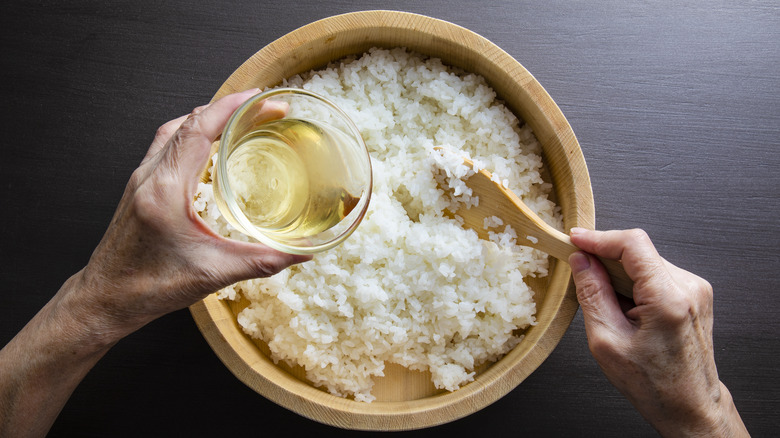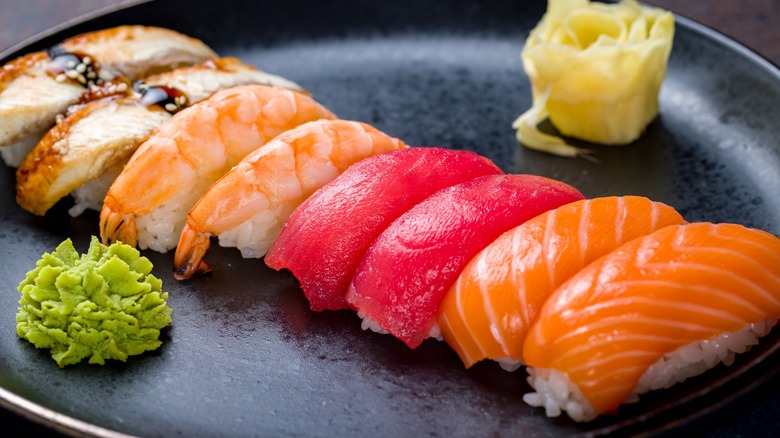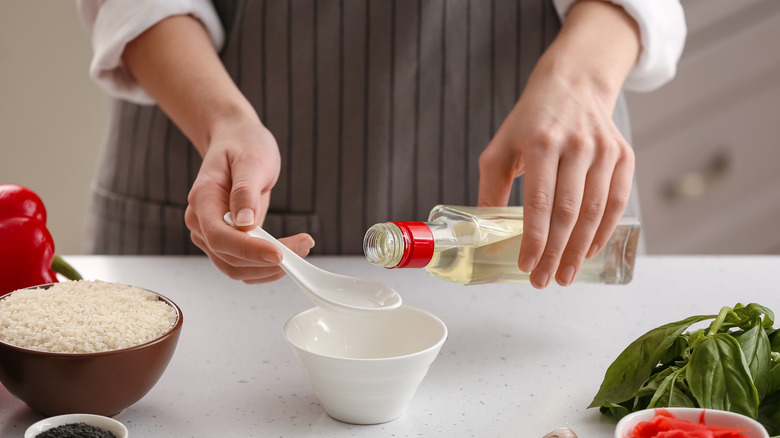Rice Wine Vinegar Is The Ingredient You Need For Acidity Without The Bitter Bite
There's a reason the keys to successfully delivering flavor are often considered to be salt, fat, acid, and heat — all four serve a purpose in making your dish as good as it can possibly be. And of those four, it's acid that serves the role of balancing dishes between all their other disparate flavor notes. You can jazz up your dish's acid level with things like lemon juice or even tarragon, but one of the key ways to hit the right levels of acidity in any dish is through the use of vinegar.
But sometimes the most commonly used types of vinegar (in America, anyway) can be a bit much. What do you do when white vinegar tastes like being punched in the face by the acid monster, balsamic vinegar is too sweet, red wine vinegar is too sour, and apple cider vinegar smells uncomfortably like feet? There's actually another type of vinegar, and it's one you should be using a lot more than you currently probably are: rice wine vinegar. Rice wine vinegar (or rice vinegar; they're the same thing) is different from rice wine, but as long as you don't mix up the two, you're going to have a great time cooking with it.
Rice wine vinegar is the secret to a lot of Asian cuisine
Unsurprisingly, rice wine vinegar comes from the same region of the world responsible for rice wine: East Asia. Though it's now widely available around the globe, it is most commonly found in China, Japan, Korea, and Vietnam. If there's a base flavor in those cuisines you really enjoy but can't quite explain, there's a good chance it could be rice wine vinegar. You know that slightly sour, yet never overpowering tang in sushi rice? That's rice wine vinegar.
The key compared to other vinegars is its subtlety. While white vinegar and red wine vinegar can have an overpowering acidic bite, and balsamic vinegar's sweetness can take over whatever it's paired with if you're not careful, rice wine vinegar comes in a lot milder. This is the reason that if you're cooking a Korean or Vietnamese dish that calls for it, you really can't substitute another vinegar type for it without completely compromising the flavor. Sushi rice is a good example again here: if you use apple cider vinegar instead of rice wine vinegar when you cook your rice, your California rolls are going to come out horribly wrong. There are, of course, different varieties of the stuff with different flavor profiles — Chinese rice vinegar is likely to be a bit stronger than a Japanese one, for example — but in general, even the strongest types of rice wine vinegar are gentler than something like western white vinegar.
You can use rice wine vinegar for a wide variety of foods
While certain Asian dishes require rice wine vinegar, that doesn't mean it doesn't have plenty of uses outside it. The key here is the mildness of its flavor; because it's more delicate than other vinegars, rice wine vinegar can be used as a substitute for most of the others in pretty much anything as long as you know what you're doing with it. It's fantastic with vegetables like kale or cabbage, where you want to bring out the flavor but don't want to drown them in acid. It's excellent as the base for vinaigrettesA because it really complements the other flavors and allows them to shine. And foods pickled in it, like red onions, will be so good you might have trouble waiting to put them on things rather than just eating handfuls straight from the jar.
The substitutions here aren't universal — you probably don't ever want to swap rice wine vinegar for balsamic vinegar, which has very specific uses — but the nice thing about milder vinegar is it's harder to accidentally overpower your food with it. For this reason, it's also an extremely accessible ingredient that shouldn't intimidate you even if you have no experience cooking with it. Go pick up a bottle of the stuff; you won't regret it.


